NISSAN PATHFINDER 1996 R50 / 2.G Repair Manual
Manufacturer: NISSAN, Model Year: 1996, Model line: PATHFINDER, Model: NISSAN PATHFINDER 1996 R50 / 2.GPages: 223, PDF Size: 1.71 MB
Page 61 of 223
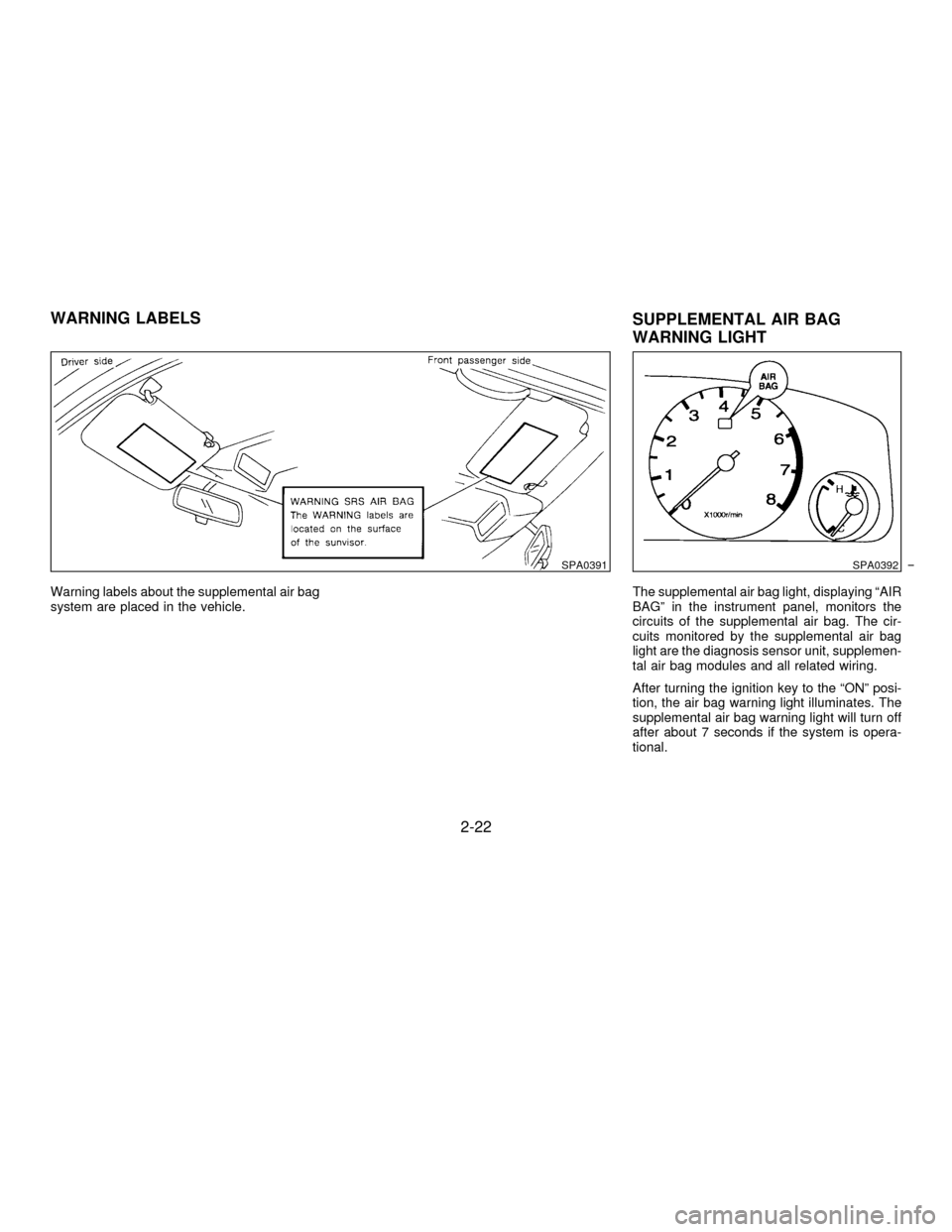
Warning labels about the supplemental air bag
system are placed in the vehicle.The supplemental air bag light, displaying ªAIR
BAGº in the instrument panel, monitors the
circuits of the supplemental air bag. The cir-
cuits monitored by the supplemental air bag
light are the diagnosis sensor unit, supplemen-
tal air bag modules and all related wiring.
After turning the ignition key to the ªONº posi-
tion, the air bag warning light illuminates. The
supplemental air bag warning light will turn off
after about 7 seconds if the system is opera-
tional.
SPA0391SPA0392
WARNING LABELS
SUPPLEMENTAL AIR BAG
WARNING LIGHT
2-22
Z01.2.1/R50-DX
Page 62 of 223

If any of the following conditions occurs, the
supplemental air bag needs servicing and
should be taken to your nearest authorized
NISSAN dealer:
1. The supplemental air bag light goes off
within 7 seconds.
2. The supplemental air bag light flashes in-
termittently or remains on (after 7 seconds).
3. The supplemental air bag light does not
come on at all.
Under these conditions, the Supplemental Re-
straint System Air Bag will not operate prop-
erly. It must be checked and repaired. Take
your vehicle to the nearest authorized NISSAN
dealer.
Repair and replacement procedure
The supplemental air bag system is designed
to inflate on a one-time-only basis. As a re-
minder, unless it is damaged, the supplemen-
tal air bag light will remain illuminated after
inflation has occurred. Repair and replace-
ment of the supplemental air bag system
should be done only by authorized NISSAN
dealers.To ensure long-term functioning,
the system must be inspected 10 years
after the date of manufacture noted on the
certification label located on the driver side
center pillar.When maintenance work is required on the
vehicle, the supplemental air bag system and
related parts should be pointed out to the
person conducting the maintenance. The igni-
tion key should always be in the ªLOCKº
position when working under the hood or in-
side the vehicle.
IOnce the supplemental air bag has
inflated, the supplemental air bag
module will not function again and
must be replaced. The supplemental
air bag module cannot be repaired.
IAfter a supplemental air bag inflates,
the front instrument panel assembly
should be replaced by your NISSAN
dealer.
IThe supplemental air bag system
should be inspected by an authorized
NISSAN dealer if there is any damage
to the front end portion of the vehicle
or replaced if the supplemental air
bag has inflated.
IWhen selling your vehicle, we re-
quest that you inform the buyer aboutthe supplemental air bag system and
guide the buyer to the appropriate
sections in this Owner's Manual.
IIf you need to dispose of a supple-
mental air bag or scrap the vehicle,
contact an authorized NISSAN dealer.
Correct supplemental air bag dis-
posal procedures are set forth in the
appropriate NISSAN Service Manual.
Incorrect disposal procedures could
cause personal injury.
2-23
Z01.2.1/R50-DX
Page 63 of 223

PRECAUTIONS ON SEAT BELT
USAGE
Your chances of being injured or killed in an
accident and/or the severity of injury may be
greatly reduced if you are wearing your seat
belt and it is properly adjusted. NISSAN
strongly encourages you and all of your pas-
sengers to buckle up every time you drive,
even if your seating position includes a supple-
mental air bag.
Some states, provinces or territories re-
quire that seat belts be worn at all times
when a vehicle is being driven.
IEvery person who drives or rides in
this vehicle should use a seat belt at
all times. Children should be in ap-
propriate child restraints.
IThe belt should be adjusted properly
and to a snug fit. Failure to do so will
reduce the effectiveness of the entire
restraint system and increase the
chance or severity of injury in an
accident.
IDo not wear the belt inside out ortwisted. Be sure the seat belt tongue
is securely fastened to the proper
buckle.
IDo not allow more than one person to
use the same belt.
IAll seat belt assemblies including re-
tractors and attaching hardware
should be inspected by your NISSAN
dealer after any collision. NISSAN
recommends that all seat belt assem-
blies in use during a collision be
replaced unless the collision was mi-
nor and the belts show no damage
and continue to operate properly.
Seat belt assemblies not in use dur-
ing a collision should also be in-
spected and replaced if either dam-
age or improper operation is noted.
INever carry more people in the ve-
hicle than there are seat belts.
If the seat belt warning lamp glows con-
tinuously while the ignition is turned
ªONº with all doors closed and all seat
belts fastened, it may indicate a mal-
function in the system. Have the system
checked by your NISSAN dealer.Be sure to observe the following cau-
tions when using seat belts. Failure to
do so could increase the chance and/or
severity of injury in an accident.
IAlways route the shoulder belt over
your shoulder and across your chest.
Never run the belt under your arm or
across your neck. The belt should be
away from your face and neck, but
not falling off your shoulder.
IPosition the lap belt as low as pos-
sible AROUND THE HIPS, NOT THE
WAIST.
ISerious injury or death can occur if
the seat belt is not worn properly.
CHILD SAFETY
Children need adults to help protect them.
All U.S. states and provinces of Canada re-
quire the use of approved child restraints for
infants and small children. (See ªChild re-
straints for infants and small childrenº later in
this section.)
In addition, there are many types of child
restraints available for larger children which
should be used for maximum protection.
SEAT BELTS
2-24
Z01.2.1/R50-DX
Page 64 of 223
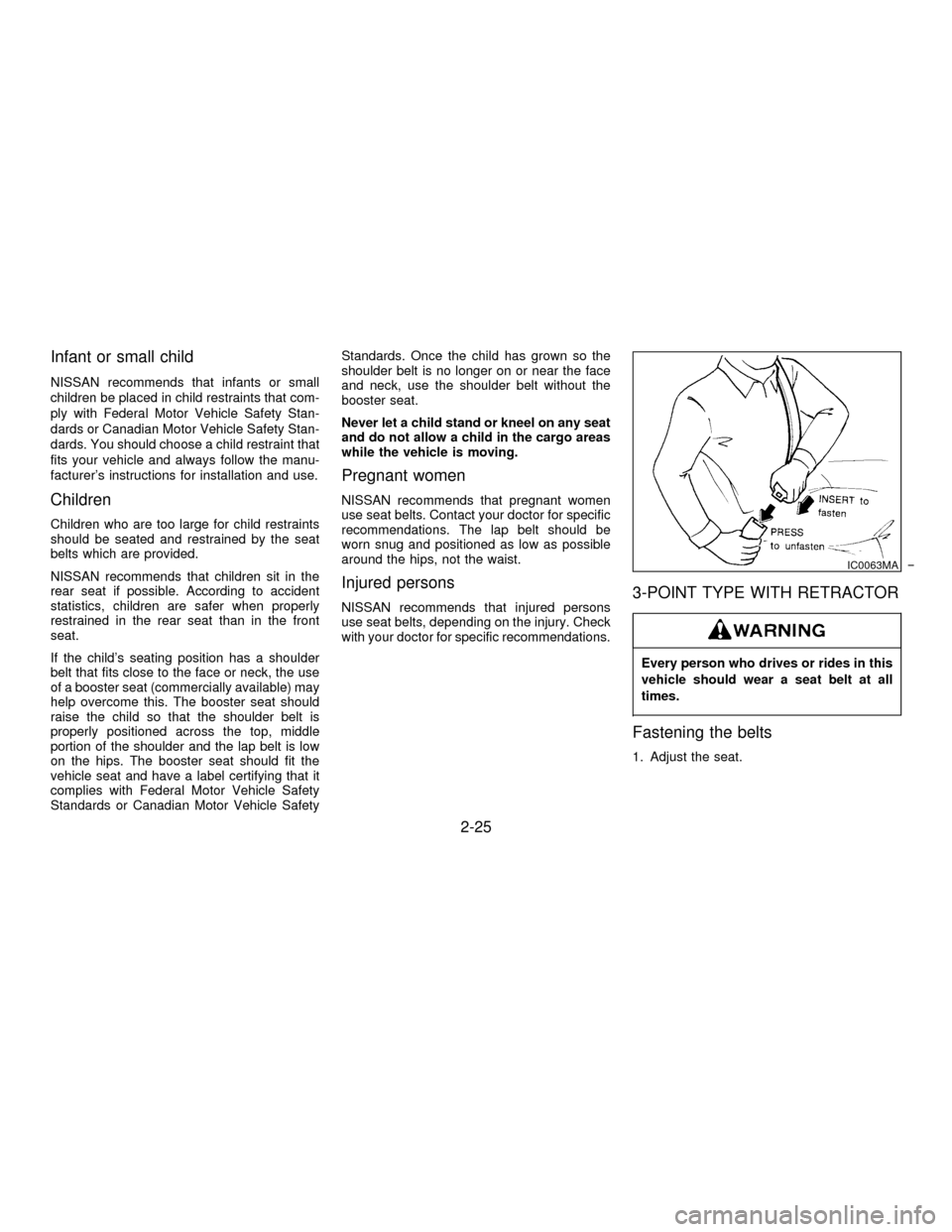
Infant or small child
NISSAN recommends that infants or small
children be placed in child restraints that com-
ply with Federal Motor Vehicle Safety Stan-
dards or Canadian Motor Vehicle Safety Stan-
dards. You should choose a child restraint that
fits your vehicle and always follow the manu-
facturer's instructions for installation and use.
Children
Children who are too large for child restraints
should be seated and restrained by the seat
belts which are provided.
NISSAN recommends that children sit in the
rear seat if possible. According to accident
statistics, children are safer when properly
restrained in the rear seat than in the front
seat.
If the child's seating position has a shoulder
belt that fits close to the face or neck, the use
of a booster seat (commercially available) may
help overcome this. The booster seat should
raise the child so that the shoulder belt is
properly positioned across the top, middle
portion of the shoulder and the lap belt is low
on the hips. The booster seat should fit the
vehicle seat and have a label certifying that it
complies with Federal Motor Vehicle Safety
Standards or Canadian Motor Vehicle SafetyStandards. Once the child has grown so the
shoulder belt is no longer on or near the face
and neck, use the shoulder belt without the
booster seat.
Never let a child stand or kneel on any seat
and do not allow a child in the cargo areas
while the vehicle is moving.
Pregnant women
NISSAN recommends that pregnant women
use seat belts. Contact your doctor for specific
recommendations. The lap belt should be
worn snug and positioned as low as possible
around the hips, not the waist.
Injured persons
NISSAN recommends that injured persons
use seat belts, depending on the injury. Check
with your doctor for specific recommendations.3-POINT TYPE WITH RETRACTOR
Every person who drives or rides in this
vehicle should wear a seat belt at all
times.
Fastening the belts
1. Adjust the seat.
IC0063MA
2-25
Z01.2.1/R50-DX
Page 65 of 223
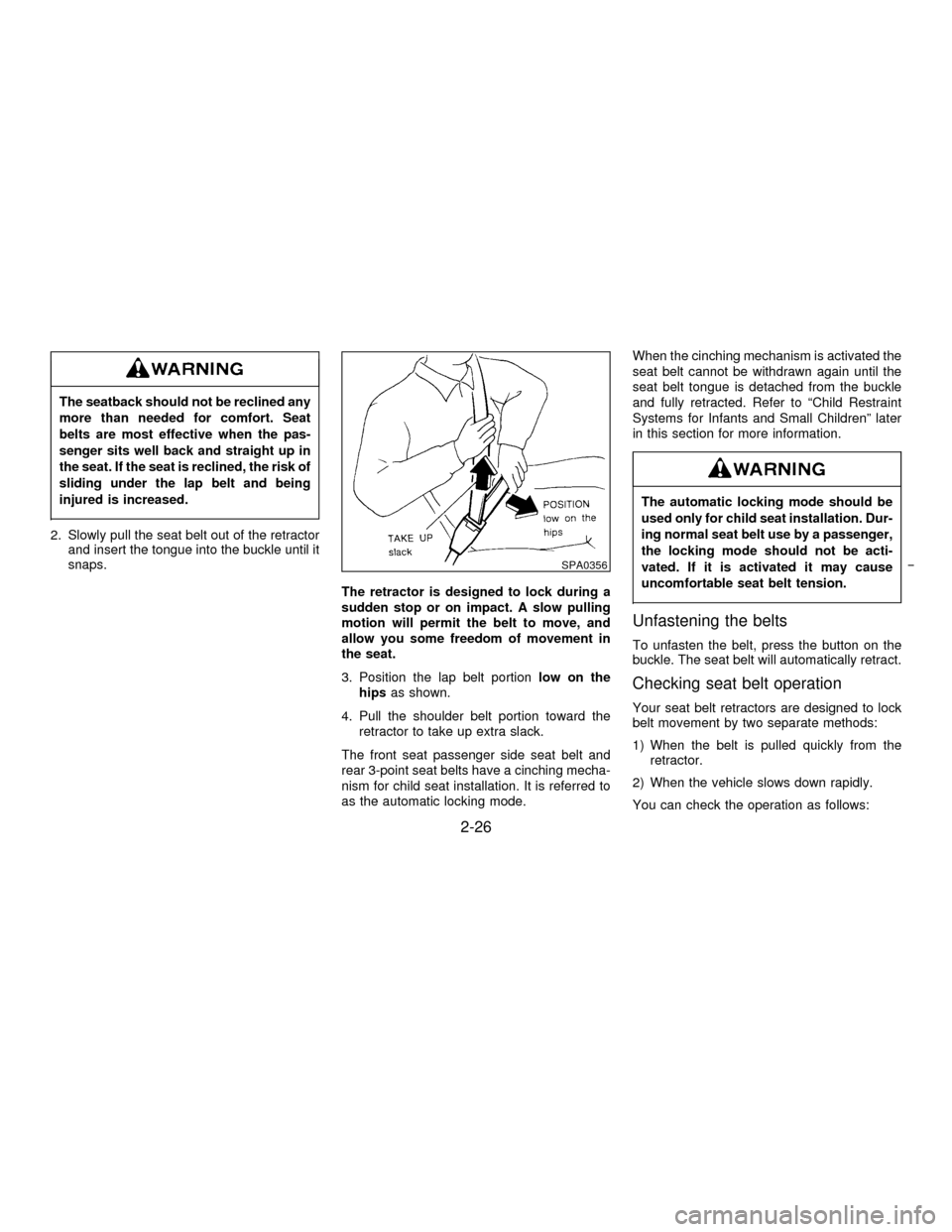
The seatback should not be reclined any
more than needed for comfort. Seat
belts are most effective when the pas-
senger sits well back and straight up in
the seat. If the seat is reclined, the risk of
sliding under the lap belt and being
injured is increased.
2. Slowly pull the seat belt out of the retractor
and insert the tongue into the buckle until it
snaps.
The retractor is designed to lock during a
sudden stop or on impact. A slow pulling
motion will permit the belt to move, and
allow you some freedom of movement in
the seat.
3. Position the lap belt portionlow on the
hipsas shown.
4. Pull the shoulder belt portion toward the
retractor to take up extra slack.
The front seat passenger side seat belt and
rear 3-point seat belts have a cinching mecha-
nism for child seat installation. It is referred to
as the automatic locking mode.When the cinching mechanism is activated the
seat belt cannot be withdrawn again until the
seat belt tongue is detached from the buckle
and fully retracted. Refer to ªChild Restraint
Systems for Infants and Small Childrenº later
in this section for more information.
The automatic locking mode should be
used only for child seat installation. Dur-
ing normal seat belt use by a passenger,
the locking mode should not be acti-
vated. If it is activated it may cause
uncomfortable seat belt tension.
Unfastening the belts
To unfasten the belt, press the button on the
buckle. The seat belt will automatically retract.
Checking seat belt operation
Your seat belt retractors are designed to lock
belt movement by two separate methods:
1) When the belt is pulled quickly from the
retractor.
2) When the vehicle slows down rapidly.
You can check the operation as follows:
SPA0356
2-26
Z01.2.1/R50-DX
Page 66 of 223
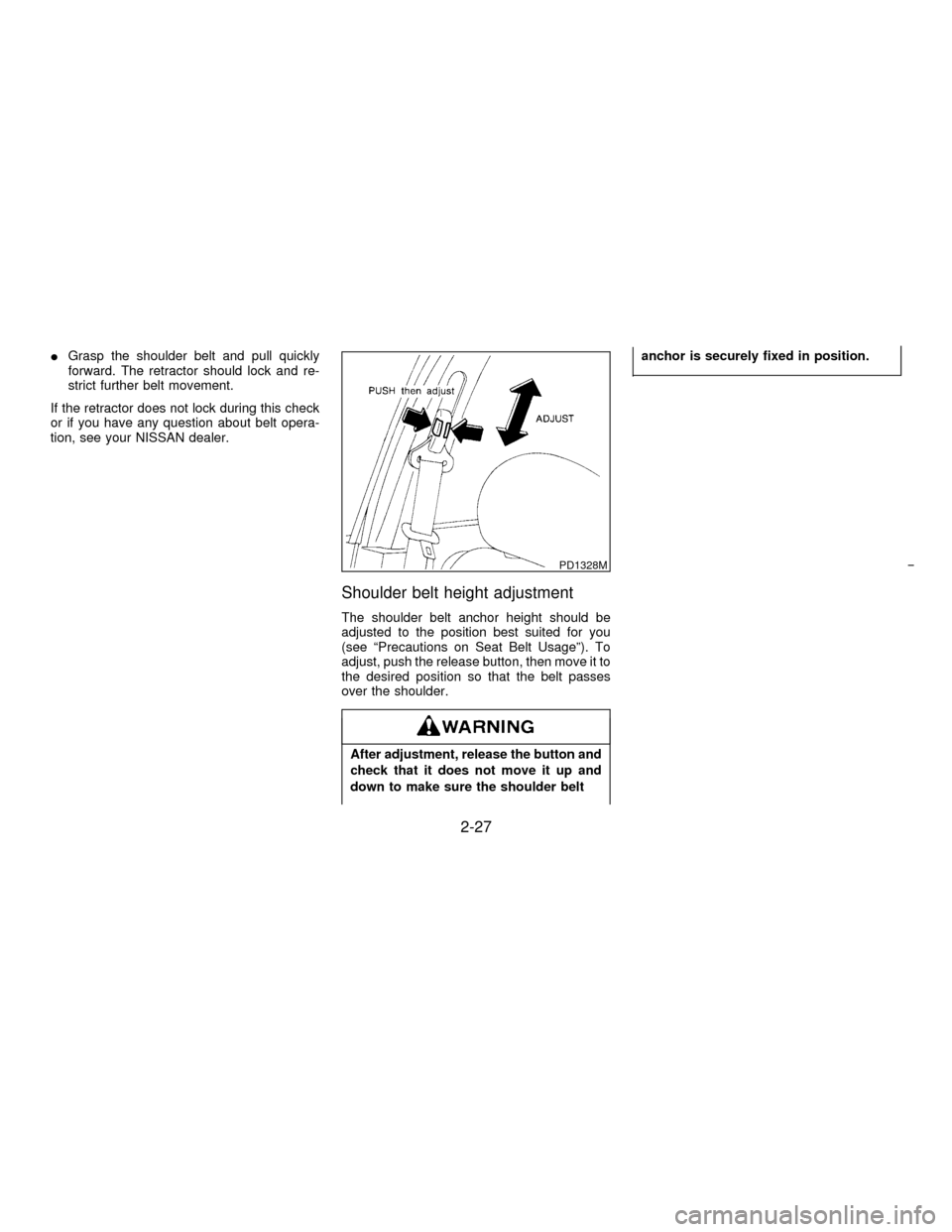
IGrasp the shoulder belt and pull quickly
forward. The retractor should lock and re-
strict further belt movement.
If the retractor does not lock during this check
or if you have any question about belt opera-
tion, see your NISSAN dealer.
Shoulder belt height adjustment
The shoulder belt anchor height should be
adjusted to the position best suited for you
(see ªPrecautions on Seat Belt Usageº). To
adjust, push the release button, then move it to
the desired position so that the belt passes
over the shoulder.
After adjustment, release the button and
check that it does not move it up and
down to make sure the shoulder beltanchor is securely fixed in position.
PD1328M
2-27
Z01.2.1/R50-DX
Page 67 of 223
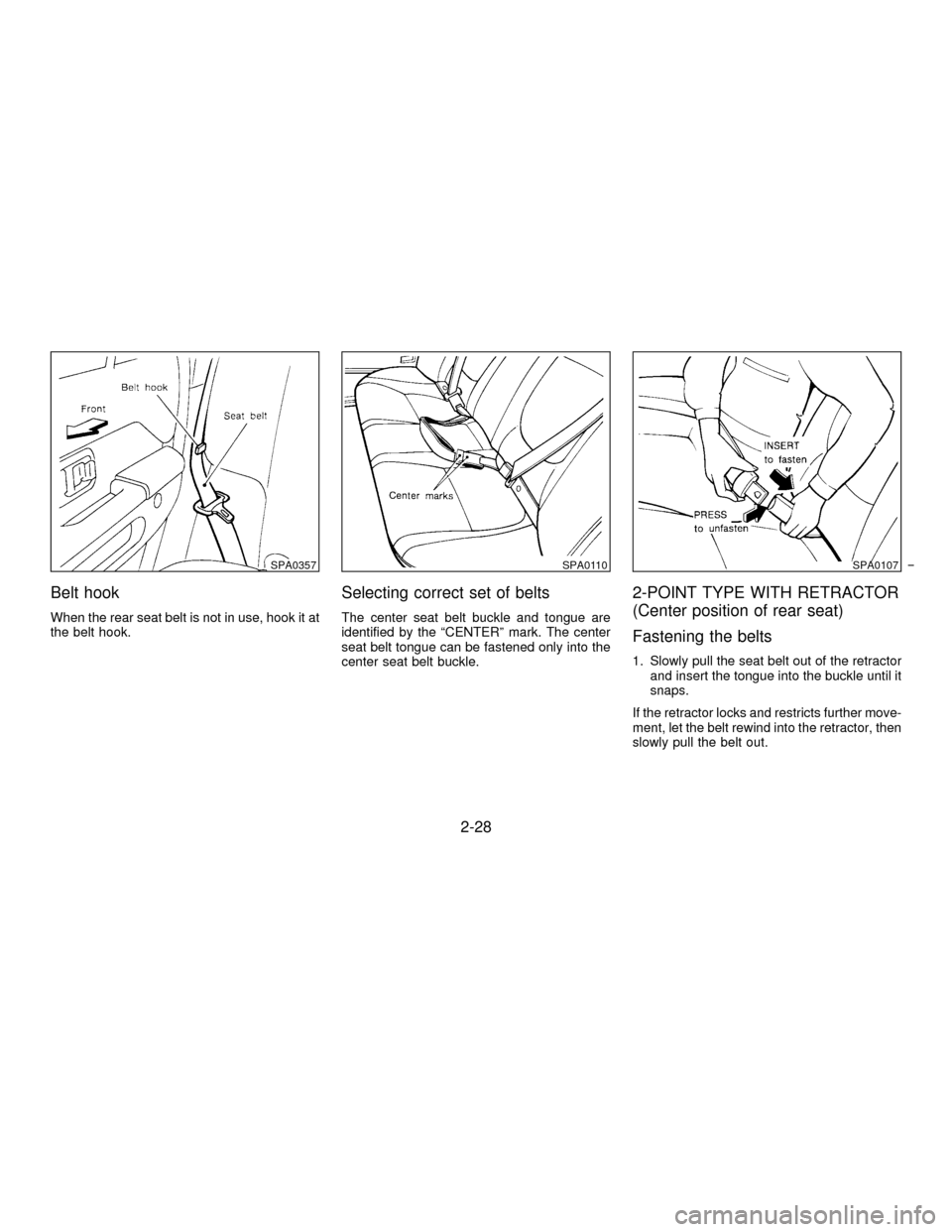
Belt hook
When the rear seat belt is not in use, hook it at
the belt hook.
Selecting correct set of belts
The center seat belt buckle and tongue are
identified by the ªCENTERº mark. The center
seat belt tongue can be fastened only into the
center seat belt buckle.
2-POINT TYPE WITH RETRACTOR
(Center position of rear seat)
Fastening the belts
1. Slowly pull the seat belt out of the retractor
and insert the tongue into the buckle until it
snaps.
If the retractor locks and restricts further move-
ment, let the belt rewind into the retractor, then
slowly pull the belt out.
SPA0357SPA0110SPA0107
2-28
Z01.2.1/R50-DX
Page 68 of 223
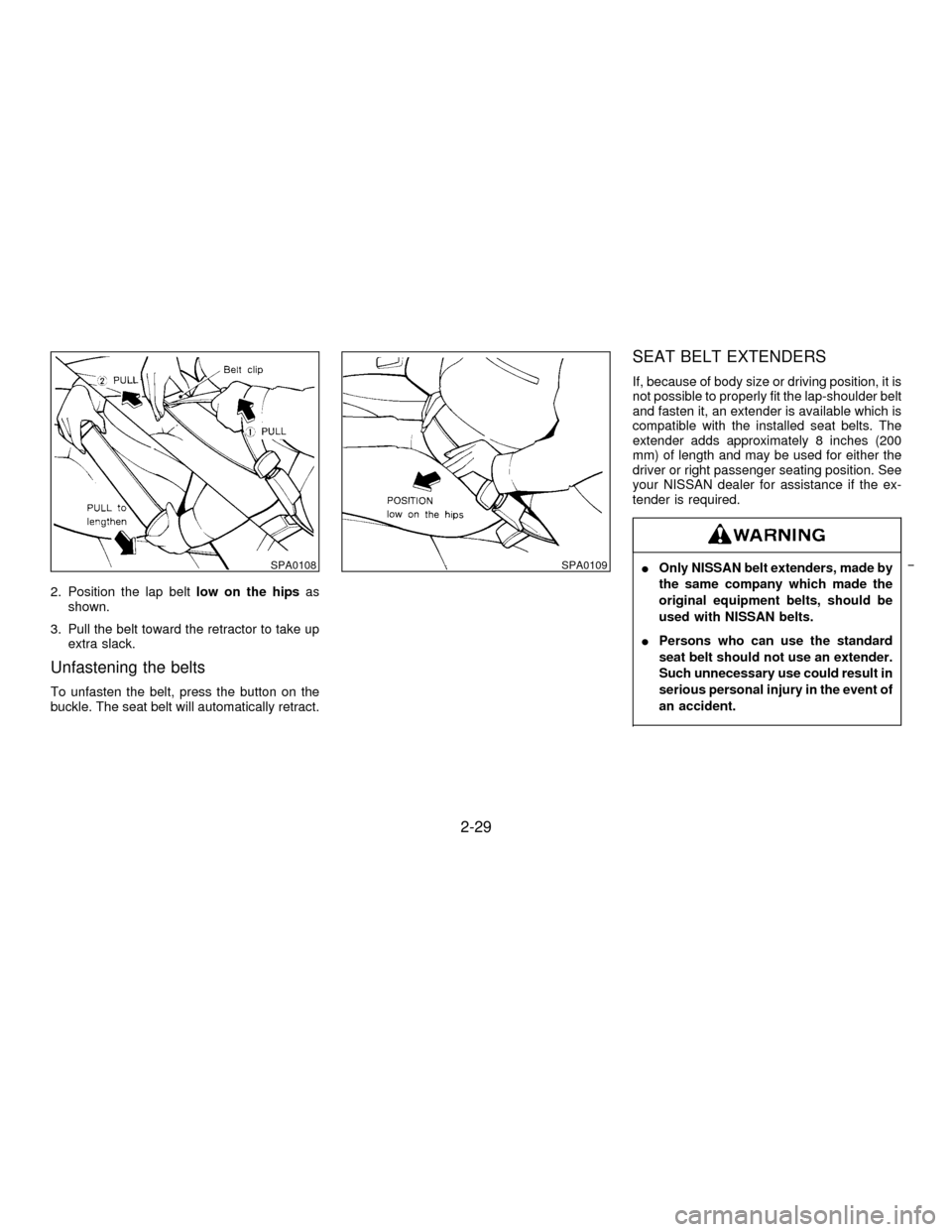
2. Position the lap beltlow on the hipsas
shown.
3. Pull the belt toward the retractor to take up
extra slack.
Unfastening the belts
To unfasten the belt, press the button on the
buckle. The seat belt will automatically retract.
SEAT BELT EXTENDERS
If, because of body size or driving position, it is
not possible to properly fit the lap-shoulder belt
and fasten it, an extender is available which is
compatible with the installed seat belts. The
extender adds approximately 8 inches (200
mm) of length and may be used for either the
driver or right passenger seating position. See
your NISSAN dealer for assistance if the ex-
tender is required.
IOnly NISSAN belt extenders, made by
the same company which made the
original equipment belts, should be
used with NISSAN belts.
IPersons who can use the standard
seat belt should not use an extender.
Such unnecessary use could result in
serious personal injury in the event of
an accident.SPA0108SPA0109
2-29
Z01.2.1/R50-DX
Page 69 of 223

SEAT BELT MAINTENANCE
ITo clean the belt webbings,apply a mild
soap solution or any solution recommended
for cleaning upholstery or carpets. Then
brush the webbing, wipe it with a cloth and
allow it to dry in the shade. Do not allow the
belts to retract until they are completely dry.
IPeriodically check to see that the belt
and the metal componentssuch as buck-
les, tongues, retractors, flexible wires and
anchors work properly. If loose parts, dete-
rioration, cuts or other damage on the web-
bing is found, the entire belt assembly
should be replaced.Infants and small children should al-
ways be placed in an appropriate child
restraint while riding in the vehicle. Fail-
ure to use a child restraint can result in
serious injury or death.
Children and infants should never be
carried on your lap. It is not possible for
even the strongest adult to resist the
forces of a severe accident. The child
could be crushed between the adult and
parts of the vehicle. Also, do not put the
same seat belt around both your child
and yourself. In general, child restraints
are designed to be installed with a lap
belt or the lap portion of a three-point
type seat belt.
Nissan recommends that the child re-
straint be installed in the rear seat. Ac-
cording to accident statistics, children
are safer when properly restrained in the
rear seat than in the front seat.
An improperly installed child restraint
could lead to serious injury or death inan accident.Child restraints specially designed for infants
and small children are offered by several
manufacturers. When selecting any child re-
straint, keep the following points in mind:
1) Choose only a restraint with a label certify-
ing that it complies with Federal Motor
Vehicle Safety Standard 213 or Canadian
Motor Vehicle Safety Standard 213.
2) Check the child restraint in your vehicle to
be sure it is compatible with the vehicle's
seat belt system.
3) If the child restraint is compatible with your
vehicle, place your child in the child re-
straint and check the various adjustments
to be sure the child restraint is compatible
with your child. Always follow all recom-
mended procedures.
INever install a rear-facing child re-
straint in the front seat. A rear-facing
child restraint must only be used in
the rear seat. See ªInstallation on
front passenger seatº for details.
IFollow all of the child restraint manu-
facturer's instructions for installation
CHILD RESTRAINTS FOR
INFANTS AND SMALL CHILDREN
2-30
Z01.2.1/R50-DX
Page 70 of 223
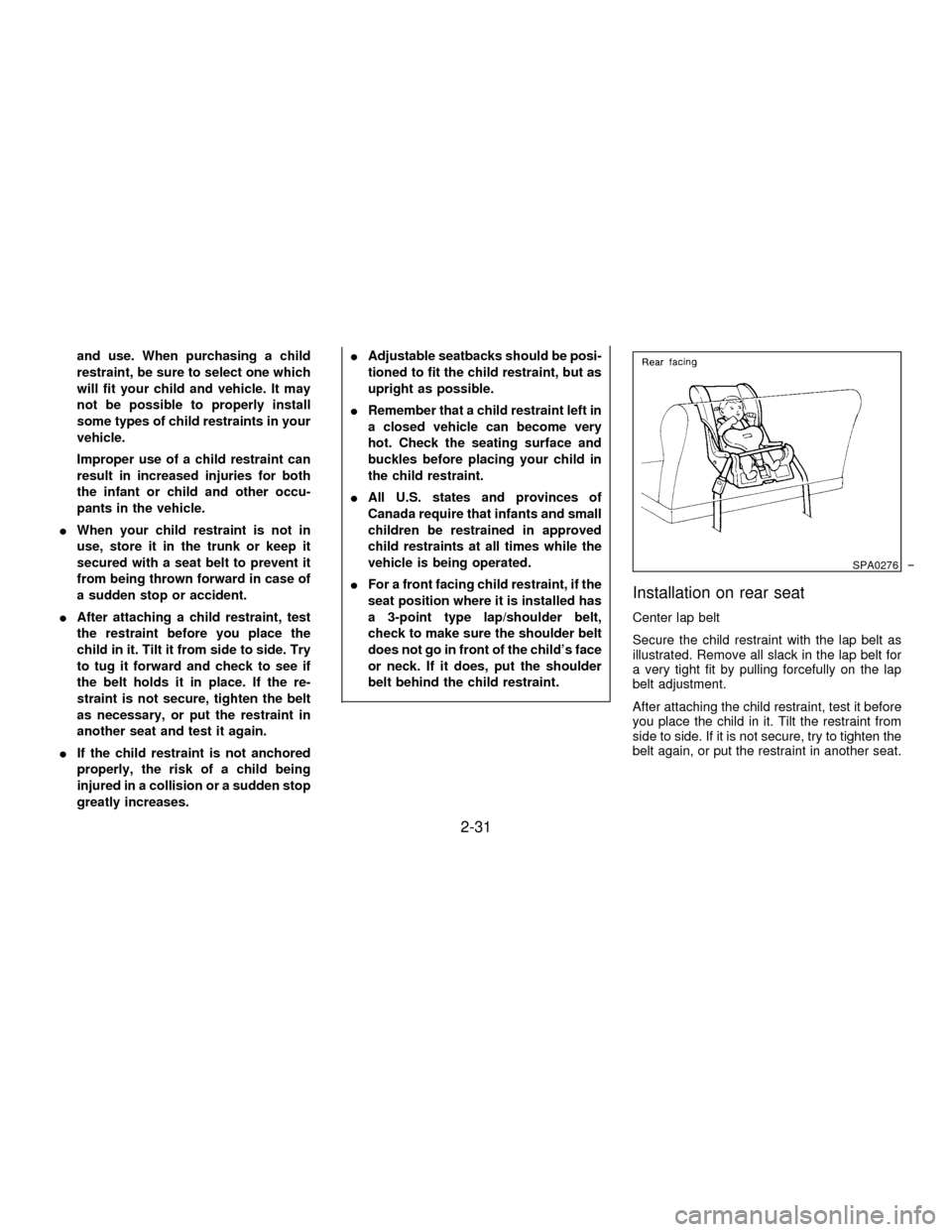
and use. When purchasing a child
restraint, be sure to select one which
will fit your child and vehicle. It may
not be possible to properly install
some types of child restraints in your
vehicle.
Improper use of a child restraint can
result in increased injuries for both
the infant or child and other occu-
pants in the vehicle.
IWhen your child restraint is not in
use, store it in the trunk or keep it
secured with a seat belt to prevent it
from being thrown forward in case of
a sudden stop or accident.
IAfter attaching a child restraint, test
the restraint before you place the
child in it. Tilt it from side to side. Try
to tug it forward and check to see if
the belt holds it in place. If the re-
straint is not secure, tighten the belt
as necessary, or put the restraint in
another seat and test it again.
IIf the child restraint is not anchored
properly, the risk of a child being
injured in a collision or a sudden stop
greatly increases.IAdjustable seatbacks should be posi-
tioned to fit the child restraint, but as
upright as possible.
IRemember that a child restraint left in
a closed vehicle can become very
hot. Check the seating surface and
buckles before placing your child in
the child restraint.
IAll U.S. states and provinces of
Canada require that infants and small
children be restrained in approved
child restraints at all times while the
vehicle is being operated.
IFor a front facing child restraint, if the
seat position where it is installed has
a 3-point type lap/shoulder belt,
check to make sure the shoulder belt
does not go in front of the child's face
or neck. If it does, put the shoulder
belt behind the child restraint.
Installation on rear seat
Center lap belt
Secure the child restraint with the lap belt as
illustrated. Remove all slack in the lap belt for
a very tight fit by pulling forcefully on the lap
belt adjustment.
After attaching the child restraint, test it before
you place the child in it. Tilt the restraint from
side to side. If it is not secure, try to tighten the
belt again, or put the restraint in another seat.
SPA0276
2-31
Z01.2.1/R50-DX